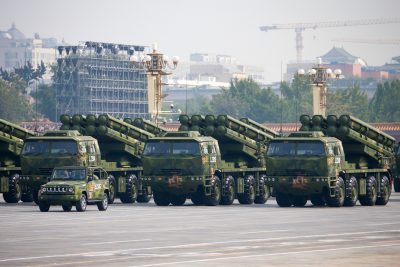China
Countering China and North Korea’s mad dash for missiles

Author: Jaganath Sankaran, University of Texas
China and North Korea have accumulated a significant arsenal of ballistic missiles. China is estimated to possess as many as 1500 short-range ballistic missiles (SRBMs) and 450 medium-range ballistic missiles. These missiles could target the United States and allied military bases in a Taiwan Strait confrontation. North Korea has close to 1000 SRBMs and approximately 300 medium-range ballistic missiles that can reach targets in South Korea and Japan.
In 2017, former director of US National Intelligence Daniel Coats testified to the US Congress that North Korea has developed precision conventional ballistic missile capabilities. The US Department of Defense 2019 Missile Defense Review also declares China’s regional ballistic missiles as a prominent weapons system in its ‘efforts to counter US military capabilities in the Indo-Pacific’ and ‘deny the United States the capability and freedom of action to protect US allies and partners in Asia’. Fortunately for Washington, it has paths towards mitigating these threats.
The United States and its allies could respond in kind and deploy missiles arrayed against Chinese and North Korean assets to establish deterrence. They could expand missile defences in the Asia Pacific region to mitigate the threat. Finally, the United States could attempt arms control mechanisms to contain, and potentially reverse, the proliferation of missiles. All of these options offer possibilities and challenges.
Understanding the motivations behind Chinese and North Korean missile pursuits will enable the evaluation of the effectiveness of these options. Beijing and Pyongyang have different ideas about the role missiles play in deterrence and warfare. Engaging in arms control, deploying countervailing offensive arms, and preparing a robust missile defence against China and North Korea present unique challenges.
North Korea does not see its missiles as a means towards reunification or as assets in a prolonged war. Rather, they are instruments of coercion and leverage to, for example, dissuade Japanese leaders from offering material or military support to South Korea or the United States in a military contingency. North Koreans hope to successfully do what the Iraqis failed to achieve in the 1991 Gulf War. The Iraqis had fired several missiles into Israel and threatened chemical weapons attacks on Israel, attempting unsuccessfully to unravel the broad coalition under US command.
The North Koreans hope to unravel Japanese support for a US-led military campaign using the threat of missile bombardment. The North Koreans also aim to use their missile arsenal to target major military airbases and naval disembarkation ports in the Asia Pacific region to prevent the assembling of US and allied forces to foreclose a Desert Storm-style military operation against it.
For North Korea, their regional missiles are tools of deterrence and defence to avoid catastrophic military defeat. Consequently, they may be unwilling to engage in standalone arms control or reductions in conventional ballistic missile arsenals unless there is a significant shift in the nature of the country’s relationship with the United States. This means that, in the near term, a combination of hardened population shelters and limited missile defences may be the most viable countermeasure to the North Korean missile threat.
Meanwhile, China has articulated a robust war-fighting strategy using its conventional ballistic missiles. Chinese military doctrine documents discuss ‘penetrating the enemy’s air defence system, striking the enemy’s in-depth targets, and seizing air and naval dominance in future local wars’. These documents speculate a missile campaign designed to degrade US and allied air defence operations, followed by an air campaign that uses cheaper precision-guided munitions to exact significant operational damage to US and allied operations.
These are still speculative concepts and may not be easily achieved by Chinese rocket forces. But evidence indicates that China is training to execute these styles of campaigns and that Chinese rocket forces have attained limited ability to execute pre-planned joint fire against targets in the Pacific theatre.
China has integrated its conventional ballistic missiles within its regional military strategy. In the near term, arms control measures such as a version of the Intermediate-Range Nuclear Forces Treaty seem improbable. US regional missile defence deployments and other defensive measures will have to deter and…
Business
China Provides Clarification on the Implementation of Article 88 (1) of the New Company Law

China’s Supreme People’s Court clarified that Article 88(1) of the New Company Law won’t apply retroactively, easing concerns for prior shareholders in equity transfers before July 1, 2024.
Clarification on Article 88(1) Non-Retroactivity
The Supreme People’s Court of China has clarified that Article 88(1) of the New Company Law will not retroactively apply to equity transfer disputes occurring before July 1, 2024. This announcement aims to address concerns from existing shareholders and resolve discrepancies in judicial decisions nationwide. Companies are advised to strengthen risk management practices for future equity transactions.
Judicial Guidance and Legal Framework
On December 24, 2024, the Supreme People’s Court issued a response reaffirming that disputes tied to equity transfers before the July 1, 2024, deadline will be governed by previous laws. This decision follows inconsistencies in judicial rulings regarding capital contributions, prompting a review by the Legislative Affairs Commission, which concluded that retroactive application was not justifiable.
Risk Management Strategies Moving Forward
Despite the ruling, equity transfers after July 1, 2024, may still attract supplemental liability under Article 88(1). To mitigate these risks, businesses should consider reducing registered capital, conducting thorough risk assessments, and implementing contractual safeguards to protect against potential liabilities.
Source : China Clarifies the Application of Article 88 (1) of the New Company Law
China
China Unveils Draft Catalogue to Promote Foreign Investment

The 2024 Draft FI Encouraged Catalogue features a national and regional sub-catalogue, highlighting industries favorable for foreign direct investment in China. It expands incentives in sectors like medical devices, batteries, new energy vehicles, pet care, elderly care, and cultural tourism.
Similar to the previous version, the Draft FI Encouraged Catalogue includes two sub-catalogues – one covers the entire country (“national catalogue”) and one covers the central, western, and northeastern regions (“regional catalogue”).
Together, the FI encouraged catalogue identifies industries where foreign direct investment (FDI) will be welcome and treated with favorable policies in China.
The lengthening of the catalogue demonstrates China’s firm standing on economic opening-up and the fact that more investment fields will favor foreign investors.
Overall, the revision of the 2024 Draft Foreign Investment (FI) Encouraged Catalogue focuses on:
In specific sectors, the new Encouraged Catalogue introduces or refines incentives for areas like medical devices, batteries, new energy vehicles, pet care, elderly care, and cultural tourism, which are worth noting.
| This article was first published by China Briefing , which is produced by Dezan Shira & Associates. The firm assists foreign investors throughout Asia from offices across the world, including in in China, Hong Kong, Vietnam, Singapore, and India . Readers may write to info@dezshira.com for more support. |
Read the rest of the original article.
China
Trump, Xi and Putin: a dysfunctional love triangle with stakes of global significance

Reports suggest a phone call between Donald Trump and Vladimir Putin hinted at a complex US-Russia relationship. Trump aims to exploit Russia-China tensions, potentially reshaping alliances and international dynamics.
Reports of a phone call between the US president-elect, Donald Trump, and his Russian counterpart, Vladimir Putin (although quickly denied by the Kremlin) have given a first flavour of the tone and direction of their relationship in the immediate future. According to the Washington Post, Trump spoke with Putin on November 7, warning him against any escalation in Ukraine and reminding him of “Washington’s sizeable military presence in Europe”.
Regardless of whether it happened or not, any – if even only indirect – exchange of messages between the pair should be heeded by America’s allies in the west, as well as Russia’s major partner in the east: China’s Xi Jinping. And there has been plenty of such messaging over the past few months.
Putin, earlier on the day of the alleged phone call, gave a long address at the annual meeting of the Valdai Discussion Club thinktank in the Black Sea resort of Sochi. Unsurprisingly, the speech – and Putin’s answers to questions from the audience afterwards – were anti-western and full of confidence that a new world order was now in “the phase of genuine creation”.
But at the same time, Putin took pains to flatter Trump as a “courageous man”, saying he’d consider any proposals from Trump aimed at restoring US-Russia relations and ending what Putin called the “Ukrainian crisis”.
But he then spent considerably more time making the case for the relationship between Russia and China. Here his audience was less the incoming US president and more his old friend the Chinese president.
The reason for this goes back to one of Trump’s messages to Putin and Xi. Trump told Tucker Carlson at a campaign event on October 31 that he would work to “un-unite” Russia and China. Trump implied that the two are “natural enemies” because Russia has vast territory that China covets for its population.
Donald Trump: US will ‘un-unite’ Russia and China.
Russia and China have a history of conflict over territory along their long land border in Siberia. This was part of the Sino-Soviet split in the 1960s, which preceded the US opening to China under then-president Richard Nixon in the 1970s.
In contrast to Nixon, Trump looks set to try to reset US relations with Moscow rather than Beijing. While it’s hard to imagine a similar split between Russia and China today, Trump’s apparent desire to exploit discord between Russia and China to the advantage of the US should not be dismissed as completely unrealistic either.
On the face of it, Putin and Xi are closely aligned. But a deeper dive into the relationship between Russia and China suggests it’s primarily one between their current leaders and lacks much of the institutional depth that other alliances have.
Putin and XI: a ‘new era’ of partnership between their two countries.
EPA-EFE/Maxim Shemetov/pool
There is a lot of resentment of China in Russia in both public and policy circles. Russians remain wary of China’s growing role in Central Asia and worry about the potential for disputes over long-contested borders. Many are also resentful of the fact that Moscow is now a junior partner to Beijing.
These are potentially all issues that Trump could use to drive a wedge between Russia and China. But a lot hinges on what Putin perceives is in it for Russia. This should be focusing minds in the west about what shape Trump’s Ukraine policy will take and what this means for Ukraine and the west.
A Trump-brokered agreement is likely to involve the recognition of Russian territorial gains in Ukraine since 2014, complete sanctions relief and broad international rehabilitation granted to Moscow. It would surely also involve a down-scaling of the US commitment to Nato and a pledge not to pursue further enlargement of the alliance.
Trump might get a deal with Putin, but whether Putin would stick to it is questionable. Putin is much more likely to simply play both sides in the hope that Russia might in this way become a third peer alongside China and the US in an emerging new international order.
This is of course a complete fantasy given the size of the Russian economy alone, but unlikely to affect Putin’s calculations, given his longing to restore Russia’s superpower status.
Chinese leverage
An American opening to Moscow, as opposed to Beijing, is also difficult to imagine because America’s European partners are unlikely to go along with it. Some, like Hungary’s Viktor Orbán and Slovakia’s Robert Fico might find the idea attractive in general, but Germany and France, among others in the EU, are more likely to want to make a deal with China.
The reason for this is economic – they have largely overcome their dependence on Russian oil and gas, but not on China as an export market.
Shared values? Donald Trump and Vladimir Putin at the commemoration of the 100th anniversary of the 1918 armistice.
EPA-EFE/Ludovic Marin
Beijing, meanwhile, won’t sit idly by while Trump tries to drive a wedge between Russia and China. Despite Putin’s efforts to build parallel relations with North Korea and Iran, Xi retains plenty of economic leverage over Russia and is going to use it to keep Russia on side.
Diplomatically, Putin depends on Xi and China-led outfits such as the Shanghai Cooperation Organisation and the Brics. While there are differences between Moscow and Beijing, they also both share a world view of a US in terminal decline – which is now likely to be further accelerated by the upheaval expected from a second Trump term.
For China in particular, preventing the US from completely pivoting to the Indo-Pacific will be a key priority – and not allowing Trump to cut a deal with Putin at China’s expense will be high on Xi’s agenda as a means to achieving that end.
Trump might still try to open up to Russia by striking a deal with Putin over Ukraine. But such a deal with Putin is not the same as dividing Russia and China. On the contrary, it is more likely to “un-unite” Europe and the US and to further weaken the transatlantic alliance.
Rather than making America great again, Trump could further hasten its decline by mistaking the destruction of what is left of the liberal international order with its reshaping according to US interests.
This article is republished from The Conversation under a Creative Commons license. Read the original article.







